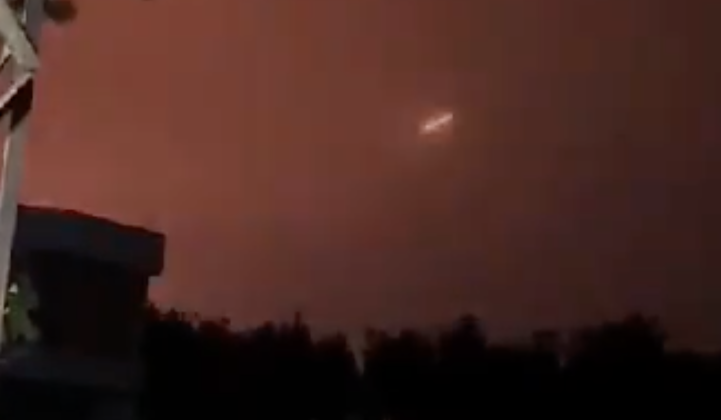The Iranian Revolutionary Guard Corps on April 13 launched multiple waves of cruise missile, ballistic missile and drone attacks on military facilities in Israel and the Israeli-held Golan heights, with these intended to “hit and destroy” multiple “important military targets.” The strikes have exclusively targeted military sites, primarily those in the Golan Heights and an air base in the Negev Desert, with the desert facility having reportedly been used to launch an Israeli air strike on an Iranian diplomatic building in Syria on April 1. An Iranian response to the attack has been anticipated for almost two weeks since, with the Israeli attack having killed a brigadier general in the elite Quds Force of the country’s Revolutionary Guard Corps Mohammad Reza Zahedi, and ten other Iranians including several long serving diplomats and General Zahedi’s deputy General Haji Rahimi. The Iranian retaliatory strike also came a day after an exchange of artillery and missile fire and drone strikes between Israel and the Iranian aligned Lebanese Hezbollah paramilitary forces. Hezbollah has reportedly launched limited rocket artillery attacks to support Iranian attacks on April 13, with this potentially intended to help overwhelm Israeli air defences.

Footage of Iranian strikes has shown missiles having penetrated deep inside Israeli airspace, including over the country’s parliament building, the Knesset, in the heavily defended Sheikh Bar district of West Jerusalem. With the strikes launched under Operation True Promise, the Revolutionary Guard Corps reported regarding its scale: “The IRGC’s Aerospace Division launched tens of missiles and drones against certain targets” within Israel. Reports indicate that over 100 drones were used. While Israel widely jammed GPS across large areas of the country, Iranian cruise missiles are known to have inertial terrain following guidance capabilities allowing them to engage pre-programmed targets without inputs from satellites or supporting aircraft. Israeli authorities have pledged a “clear and decisive” response to the Iranian strikes, although it remains uncertain whether an escalatory spiral could lead to full scale war between the two states. While Iran is expected to continue to be supported by Hezbollah, neighbouring Syria, and various allied militia groups across the region, in particular in Iraq and Yemen, Israel is likely to be strongly supported by multiple NATO member states including Britain, Turkey and the United States.

Spokesperson for the National Security Council at the White House Adrienne Watson stated following the first waves of Iranian strikes: “Iran has begun an airborne attack against Israel. President Biden is being regularly updated on the situation by his national security team and will meet with them this afternoon at the White House. His team is in constant communication with Israeli officials as well as other partners and allies… This attack is likely to unfold over a number of hours. President Biden has been clear: our support for Israel’s security is ironclad. The United States will stand with the people of Israel and support their defence against these threats from Iran.” Multiple reports indicate that Israeli air defence efforts have been significantly bolstered by American support, including provision of data warning of the launch of drones and missiles shortly after they left the ground in Iran, and active responses by American air defences to shoot down incoming targets. Jordanian forces, which have been closely aligned with the U.S. and Israel against Iran and its allies have also contributed to shooting down missiles on course to Israel. U.S. President Joe Biden claimed regarding American involvement in air defence efforts: “At my direction, to support the defence of Israel, the U.S. military moved aircraft and ballistic missile defence destroyers to the region over the course of the past week. Thanks to these deployments and the extraordinary skill of our servicemembers, we helped Israel take down nearly all of the incoming drones and missiles.”

American support is expected to be of particular value should Israel seek to mount a response by striking targets in Iran, with the Iranian Revolutionary Guard Corps having explicitly warned the U.S. that “any support” Washington provided to Israel in “harming Iran’s interests” would be met with a “decisive” response. The United States began a sudden and very large military buildup in the Middle East from early October, which at the time included deployment of a Marine Rapid Response Force led by the amphibious carrier USS Bataan, two U.S. carrier strike groups led by Nimitz and Gerald Ford class nuclear powered supercarriers, A-10 attack jets from the 354th Fighter Squadron, F-15E strike fighters, Patriot and THAAD air defence systems, and a range of other aerial warfare assets. While American officers are confirmed to have been deployed to advise Israeli forces on the ground, and drones have been deployed for the first time for operations over the Gaza Strip, American special forces are also reported to have engaged Palestinian militias in combat in support of Israeli forces. While Israel’s capability for strikes on Iranian territory remains relatively limited, the U.S. retains a wide range of assets in the region capable of striking Iranian targets. Israel’s own independent strike capability against Iran is also set to be expanded considerably with the sale of F-15EX fighters which are by far the longest ranged in the Western world, with American approval for such a deal reported in early April to be imminent.
